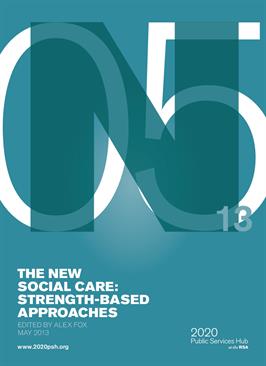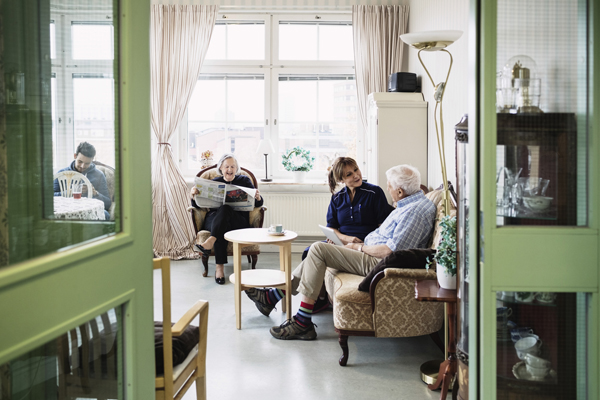The only access point, a humiliating demonstration of vulnerability and dependency. It is a deficit model that has dominated practice and policy for decades. Yet it is now clearer than ever that it is unsustainable. Social care is consuming an ever greater share of Council resources while the number whose needs it meets is paradoxically diminishing, shunting costs onto the NHS and leaving increasing numbers of people struggling to cope.
The 2012 Care and Support White Paper was a call to action that championed an asset-based approach to stem the tide of need and harness the strengths of the individual and their community. But will it prove to be a milestone on the road to real change or a gravestone marking the end of a brief period of optimism?
As the contributors to this pamphlet demonstrate, there are grounds for optimism. The state of public finances may be the trigger, but the case for radical change has been building for years.
As the Care and Support Minister until September 2012, I had responsibility for drafting and then piloting the White Paper through Whitehall. It was an opportunity to translate liberal ideas of reciprocity and resilience into Government policy and legislation, ideas that I had talked about in opposition for over a decade and which had been pioneered by a growing number of professionals in their practice.
As a liberal I believe that independence at its best is achieved within a community of interdependence. The strength of communities is their capacity to mobilise individual and collective responses to adversity. Community is more than a simple matter of geography. It is about how people connect with each other, the power of relationships and reciprocity, whether based on common interests, friendship, or the giving and receiving of support. These networks of informal ties are what make up the many and diverse communities each of us benefit from. And – as we may all know – without community, independence can become miserable isolation.
Yet these networks are sadly not a given. The White Paper is clear that practice needs to be much more focused on recognising and building links between the strengths of individuals and communities, not only on waiting to come to the rescue of casualties when networks fail.
This approach suggests that if the care plans for an older person just looks at the two hours a day when they need formal help and ignores the other 22, it has missed the point.
The most important links in that person’s network may be their neighbours who pop round for a chat, their children who deal with the bills while they watch their grandchildren or the weekly scrabble tournament with an old friend.
Mapping these networks, whether they consist of five people or fifty, whether they are local or more distant, should be the starting point for care planning, not an optional extra. This is the only way to achieve the White Paper’s aspiration of putting prevention and well-being at the heart of social care.
As Sandie Keene describes in her contribution, these ideas are not new. Leeds’ Neighbourhood Networks have evolved over the past 20 years and have changed the way care and support is organised and delivered in the City.
Indeed, almost 50 years ago, the Seebohm report recognised the need to break the vicious circle of crisis care and argued against a ‘symptom-based approach’. And this vision of well-being and community involvement was restated in the 1982 Barclay report which argued that social work should be a balance between casework and community work.
Neither Seebohm nor Barclay prevailed. So will it be different this time?
One of the reasons past attempts at shifting the focus onto well-being and community have failed is that when resources are under pressure, practice defaults to the minimum requirements of the 1948 National Assistance Act.
That is where the Care and Support Bill comes in. It establishes a new mission for social care: the promotion of individual well-being.
Having framed the policy and the legislation while in Government, I did not expect to have opportunity to look at it afresh; some might say to mark my own homework. But as Chair of the Joint Committee of Peers and MPs scrutinising the draft Bill I have done just that. While the Bill has been widely praised there remain missed opportunities, and as Alex Fox argues in his contribution, the draft bill needs to be amended to make a reality of the White Paper’s ‘radicalism’.
However, while getting the policy right is essential, it will not be sufficient. There needs to be a social movement that draws on practice to demonstrate what works, and successfully drive change. The contributors to this pamphlet offer both vision and practical ways forward. Things can be different, and in some places a new approach is beginning to gather momentum.
The change has started. Now we must quicken the pace.
pdf 1 MB
Contributors


Related reports
-
Move fast and fix things: How to be a public entrepreneur
This report describes the findings from a six-month inquiry where we applied the RSA’s model of change “think like a system, act like an entrepreneur” to the challenges of procuring and scaling innovation through government.
-
Health as a social movement: theory into practice
The RSA and NEF in partnership with NHS England publish a report to develop a community-led health system.
-
Releasing energy for change in our communities: social movements in health
How can we liberate and harness energy for change in our communities? Reflections from the Health as Social Movement project.



